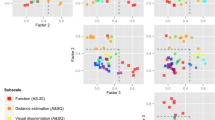Abstract
Background
Visible strabismus has been shown to have adverse psychosocial consequences. It remains controversial if esotropia or exotropia is perceived more negatively. The aim of this study was to determine if esotropia or exotropia and the eye (side) in which strabismus is present are perceived differently. We also asked our adult participants: (1) if they thought visible strabismus should be corrected by surgery, (2) if they thought that strabismus surgery should only be to improve the cosmesis, and (3) if they thought that the surgery should be paid for by health insurance.
Methods
One hundred adults and 61 children rated four photographs of a digitally altered picture of a boy and four of a girl, showing a large-angle esotropia or exotropia either in the left or on the right eye. The adults were additionally asked if a squint should be operated, if they considered strabismus surgery to be a cosmetic procedure, if in their opinion strabismus surgery should be covered by compulsory health insurance, and if children with strabismus are disadvantaged. Comparisons were performed using ANOVA and regression analysis.
Results
Adults perceived a squinting right eye as more disturbing than a squinting left eye p < 0.001). The direction of strabismus, the age, gender, and the number of persons with a squint among family and friends of the respondents did not influence the perception of strabismus by adults (p > 0.1 for each). Children also found that a squinting right eye is more disturbing (p < 0.001) than a left one. Additionally, children ranked esotropia worse than exotropia (p < 0.001). Neither age nor gender had an impact on the perception of strabismus by children. Of the adults, 94% would recommend surgery for all forms of strabismus, 18% thought that surgery is only cosmetic, and 94% found that health insurance should cover strabismus surgery for everybody. Problems of squinting children named by the adults included: being made fun of by other children (53%), problems with eyesight (39%), people looking strangely at them (21%), less acceptance by peers (17%), less self confidence (6%), problems judging distances (4%), and that they are perceived as less intelligent (3%).
Conclusions
Adults and children rated a squinting right eye as worse compared to a left one. Children perceived esotropia as more disturbing than exotropia. Neither age, nor gender, nor the fact that the respondents have friends or family members with a squint, had an impact on this ranking. Almost all adults would correct all forms of strabismus, and think that surgery should be covered by compulsory health insurance.


Similar content being viewed by others
References
Beauchamp GR, Felius J, Stager DR, Beauchamp CL (2005) The utility of strabismus in adults. Trans Am Ophthalmol Soc 103:164–171
Coats DK, Paysse EA, Towler AJ, Dipboye RL (2000) Impact of large angle horizontal strabismus on ability to obtain employment. Ophthalmology 107:402–405
Goff MJ, Suhr AW, Ward JA, Croley JK, O'Hara MA (2006) Effect of adult strabismus on ratings of official U.S. Army photographs. J AAPOS 10:400–403
Heath RL, Rouhana A, Ghanem DA (2005) Asymmetric bias in perception of facial affect among Roman and Arabic script readers. Laterality 10:51–64
Hsiao JH, Cottrell G (2008) Two fixations suffice in face recognition. Psychol Sci 19:998–1006
Johns HA, Manny RE, Fern KD, Hu YS (2005) The effect of strabismus on a young child's selection of a playmate. Ophthalmic Physiol Opt 25:400–407
Menon V, Saha J, Tandon R, Mehta M, Khokhar S (2002) Study of the psychosocial aspects of strabismus. J Pediatr Ophthalmol Strabismus 39:203–208
Mojon-Azzi SM, Mojon DS (2007) Opinion of headhunters about the ability of strabismic subjects to obtain employment. Ophthalmologica 221:430–433
Mojon-Azzi SM, Mojon DS (2009) Strabismus and employment: the opinion of headhunters. Acta Ophthalmol 87:784–788
Mojon-Azzi SM, Potnik W, Mojon DS (2008) Opinions of dating agents about strabismic subjects' ability to find a partner. Br J Ophthalmol 92:765–769
Olitsky SE, Sudesh S, Graziano A, Hamblen J, Brooks SE, Shaha SH (1999) The negative psychosocial impact of strabismus in adults. J AAPOS 3:209–211
Paysse EA, Steele EA, McCreery KM, Wilhelmus KR, Coats DK (2001) Age of the emergence of negative attitudes toward strabismus. J AAPOS 5:361–366
Satterfield D, Keltner JL, Morrison TL (1993) Psychosocial aspects of strabismus study. Arch Ophthalmol 111:1100–1105
Shillcock R, Ellison TM, Monaghan P (2000) Eye-fixation behavior, lexical storage, and visual word recognition in a split processing model. Psychol Rev 107:824–851
Uretmen O, Egrilmez S, Kose S, Pamukcu K, Akkin C, Palamar M (2003) Negative social bias against children with strabismus. Acta Ophthalmol Scand 81:138–142
Wagner RS (2002) Other benefits of strabismus surgery. J Pediatr Ophthalmol Strabismus 39:197
Author information
Authors and Affiliations
Corresponding author
Additional information
The authors have no financial interest in the topic of this article.
Grants/financial supports
None
Rights and permissions
About this article
Cite this article
Mojon-Azzi, S.M., Kunz, A. & Mojon, D.S. The perception of strabismus by children and adults. Graefes Arch Clin Exp Ophthalmol 249, 753–757 (2011). https://doi.org/10.1007/s00417-010-1555-y
Received:
Revised:
Accepted:
Published:
Issue Date:
DOI: https://doi.org/10.1007/s00417-010-1555-y




